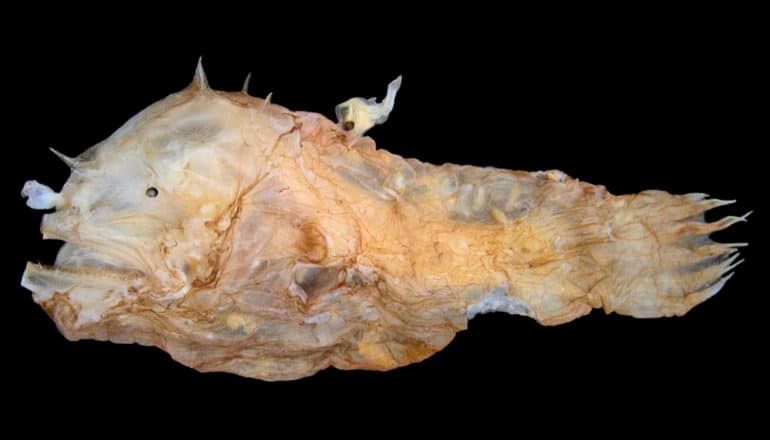
New research on deep-sea anglerfishes help square their reproductive strategy, called “sexual parasitism,” with the immune system.
Among deep-sea anglerfishes, tiny dwarfed males become permanently attached to relatively gigantic females, fuse their tissues, and then establish a common blood circulation. In this way, the male becomes entirely dependent on the female for nutrient supply, like a developing fetus in the womb of a mother or a donated organ in a transplant patient.
In anglerfishes, this unusual phenomenon contributes to the reproductive success of these animals living in the vast space of the deep sea, where females and males otherwise rarely meet.
Now scientists have figured out why female anglerfishes so readily accept their male mates. Their findings appear in Science.
The enigma of this extraordinary reproductive strategy has persisted for a century, ever since an Icelandic fisheries biologist discovered the first attached fishes in 1920.
“How is it possible that genetically similar organisms—in this case, members of the same species—accept each other so readily when tissue rejection is the usual and expected result of any such union?” says coauthor Ted Pietsch, professor emeritus at the University of Washington School of Aquatic and Fishery Sciences. “Just witness the difficulties surrounding organ transplantation in humans. We now see great potential down the road for a better understanding of the problem.”
Female and male anglerfishes
Deep-sea anglerfishes are found in all oceans around the world, yet the roughly 160 known species are extremely rare. They lure their prey in the inky-black ocean darkness at depths between 300 and 5,000 meters (980 and 16,400 feet) using a bioluminescent fishing apparatus placed on the tip of the snout—hence the “angler” in their common name. Their enormous, toothy mouth and expandable stomach enable them to capture and devour prey larger than themselves in a single instantaneous gulp.
“For humans, the combined loss of important immune facilities observed in anglerfishes would result in fatal immunodeficiency.”
Deep-sea anglerfish males are a fraction of the size of the females—in the most extreme cases, females may be more than 60 times the length and about a half-a-million times as heavy as the males. The males don’t have a luring apparatus; instead, most have large, well-developed eyes and huge nostrils, which help them home in on a species-specific chemical attractant emitted by the females.
For decades, researchers have wondered how this rare phenomenon happens in anglerfish. Several years ago, Thomas Boehm, a medical doctor and immunologist at the Max Planck Institute of Immunobiology and Epigenetics in Germany, and Pietsch, an ichthyologist and the world’s expert on anglerfishes, set out to study the genomes of different anglerfish species.
Unusual immune systems
They began by looking at the structure of major histocompatibility (MHC) antigens. These molecules are found at the surface of the body’s cells and signal alarm to the immune system, when the cells are infected by a virus or a bacterium.
To make sure that all pathogens are efficiently recognized, the MHC molecules are extremely variable, so much so that it is hard to find identical or near-identical forms in any two individuals of a species. This feature is at the root of the tissue-matching problem that plagues human organ and bone marrow transplantation. To their great surprise, the researchers found that anglerfishes that utilize permanent attachment largely lack the genes that encode these MHC molecules, as if they had done away with immune recognition in favor of tissue fusion.
Additionally, they found that the function of killer T cells, which normally eliminate infected cells or attack foreign tissues during the organ rejection process, was also severely blunted, if not lost entirely, in anglerfishes. Further analysis also indicated that antibodies, another powerful weapon in the arsenal of immune defense, are missing in some anglerfish species.
“For humans, the combined loss of important immune facilities observed in anglerfishes would result in fatal immunodeficiency,” Boehm says.
The researchers found that anglerfishes lack the genes responsible for tissue rejection and instead use much improved innate facilities to defend themselves against infections, a most unexpected solution to a problem that is faced by all living things. In other words, their new type of immune system is very unusual among the tens of thousands of vertebrate species.
The study thus shows that despite several hundred million years of co-evolutionary partnership of innate and adaptive functions, vertebrates can survive without the adaptive immune response previously considered to be irreplaceable.
“We find it remarkable that the unusual mode of reproduction was invented several times independently in this group of fishes,” Pietsch says.
Although the details of the improved innate immune response in anglerfishes remain to be discovered, the results of this study point to potential strategies that enhance innate immune facilities in human patients who suffer the consequences of inborn or acquired impairment of immune facilities.
Other coauthors are from the Max Planck Institute of Immunobiology and Epigenetics. The Max Planck Society, the Ernst Jung Foundation for Science and Medicine, the European Research Council, and the National Science Foundation funded the work.
Source: University of Washington via Max Planck Institute of Immunobiology and Epigenetics
The post Odd immune system lets anglerfishes fuse males to females appeared first on Futurity.
from Futurity https://ift.tt/2EGllMR
No comments:
Post a Comment